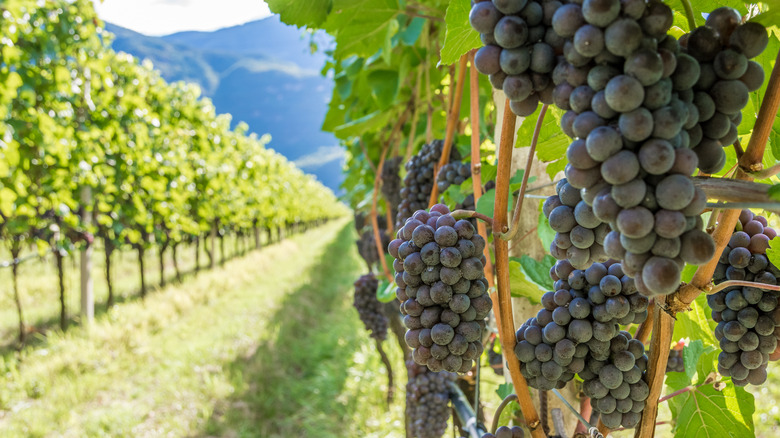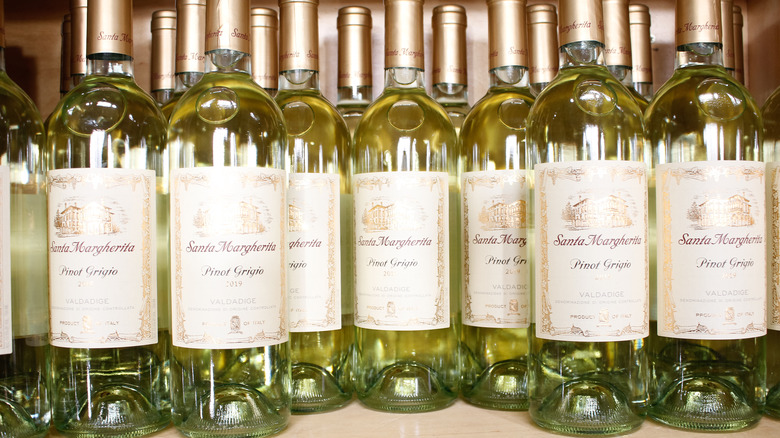Everything You Need To Know About Pinot Grigio
Whether you're looking for a weeknight wind down, enjoying a happy hour in the sunshine, or looking to spruce up your next seafood dinner, sometimes there's nothing better than a cool, refreshing glass of white wine. And for many of us, the go-to glass of choice is a crisp, fruity Pinot Grigio. This dry, predominantly Italian wine variety has a long history and a complicated reputation, but there's much more to this drink than meets the eye.
Despite the haters out there who look down upon this wine, The Globe and Mail reports that Pinot Grigio is hugely popular in the United States and around the world, perhaps more so now than ever. Per Wine Enthusiast, the wine variety saw a huge boost in sales during the COVID-19 pandemic, as more and more of us were reaching for easygoing everyday sippers to get us through the weeks stuck at home in quarantine. So there's no better time to learn about this buoyant beverage. Pour yourself a glass and keep reading for everything you need to know about Pinot Grigio wine.
Pinot Grigio comes from France
Pinot Grigio has a long history that goes back thousands of years. The grapes that produce this wine originated in the Burgundy region of France, dating back sometime in the Middle Ages (via Vinovest), where it was originally called Pinot Gris. It's important to note that today, Pinot Gris and Pinot Grigio aren't quite the same — but more on that later. Pinot Gris officially got on the record by 1375, when Emperor Charles IV — who was said to be a big fan of the wine — decided to spread the vines to other parts of the Holy Roman Empire, according to David Lett, a winemaker and expert.
In the centuries that followed, Pinot Gris grapes made their way to other parts of France, Germany, Italy, and beyond. It is believed that the grapes were introduced in Italy in the 19th century, according to The Drinks Business. That's where the Pinot Grigio we know and love today was developed and quickly became popular in the country and farther afield (via VinePair).
Pinot Grigio is predominantly made in Northern Italy
While Pinot Grigio grapes were born in France under the name Pinot Gris, the reality is that these days, Pinot Grigio wine is beloved across the globe. It is produced in several different places around the world, with Northeastern Italy leading the way (via Masterclass). Wine-Searcher calls this region of Italy — which includes Veneto, Friuli-Venezia Giulia, and Trentino-Alto Adige — the "Pinot Grigio producing heartland." It accounts for more than half of global Pinot Grigio production, corking up around 260 million bottles a year to feed the international demand (via Wine Business International).
Outside of Italy, the second leading producer of Pinot Grigio wine is the United States, which accounts for about 14% of global production, according to Wine Business International. The Alsace region of France and Germany are also major producers of their own version of the wine, while some notable varieties hail from New Zealand as well (via Wine Spectator). You'll also find some decent Pinot Grigio made in southern Australia as well (via Wine Selectors).
Pinot Grigio and Pinot Gris are not the same
If you're reading up on Pinot Grigio, you'll notice a lot of references to Pinot Gris. You might even see some claims that Pinot Grigio and Pinot Gris are the same things, the only difference being that the former comes from Italy and the latter comes from France (via Martha Stewart). This isn't technically correct, however, though the truth admittedly gets a little complicated as the histories of these wines intertwine.
Pinot Grigio and Pinot Gris are indeed incredibly similar because they are produced from the same grape. The grape is usually referred to as Pinot Gris because it was first developed in France's Burgundy region. However, once the grape made its way to Italy, it was used to develop what we know as Pinot Grigio (via VinoVest). The difference, therefore, lies more in how the grapes are managed and how these two different countries produce notably different wines.
It's true that these days the same grape is used to produce Pinot Gris in France (mostly in the Alsace region) and the wildly popular Pinot Grigio in Italy. But the two wines are in fact different styles with their own unique characteristics. Pinot Grigio tends to be lighter-bodied and crisp, with strong fruit and floral notes. Pinot Gris is more full-bodied than its Italian counterpart, with a deeper, richer flavor, and even spicy notes depending on the winemaker in particular (via Kitchn). Additionally, Pinot Grigio is typically drier than Pinot Gris.
Pinot Grigio is named for the color of its grapes
Whether you're referring to Pinot Grigio or Pinot Gris, both are named for the color of the grapes that they are produced from. While most white wine grapes are green, Pinot Grigio grapes are typically a striking, classic bluish-gray color (via VinePair). That unique gray color is what gives this wine its name. Gris is the French word for gray, and grigio is the same term in Italian.
It is worth noting, though, that the grape variety used to make Pinot Grigio is believed to be a genetic mutation of red Pinot Noir grapes (via L.A. Times). All the grapes in the family are known for being genetically unstable, so the color is not always consistent, even within a single cluster of grapes on the same vine (via Wine Traveler). As a result, some Pinot Grigio grapes can be purple, white, pink, even carry a hint of brown (via Science of Cooking). These different colors don't necessarily affect the color or taste of the wine, because it's mostly made from grape flesh. The skins, which would impart some color, aren't fermented with the rest of the grape for very long and so can't lend much of their tone to the final wine.
Americans have only been drinking Pinot Grigio for 40 years
While Pinot Grigio has been around for centuries and seemingly everyone just about everywhere has tried it, Americans have only been drinking it for a few decades. According to VinePair, the wine was first introduced in the U.S. in 1979. And if you're one of the many Americans who love a glass of this fruity, dry white wine at happy hour, you can thank a man named Anthony Terlato for its popularity since its stateside debut. The New York Times called him a "visionary wine importer and marketer," but he's most famously known as the man who introduced Americans to Pinot Grigio.
Over his long career in the winemaking industry, Terlato was responsible for acquainting Americans with many several different wines that are commonly beloved today (via Terlato Wines). In the late '70s, sensing a shift in American culinary tastes, Terlato made a deal with a prominent northern Italian Pinot Grigio producer, Santa Margherita, and gave causal wine sippers in the states the dry, crisp alternative to Chardonnay they didn't even know they were missing. He became so instrumental to the popularization of the variety that Terlato Wines claims he became widely known as the "Father of Pinot Grigio" for his efforts.
Pinot Grigio is the second most popular white wine in America
If Pinot Grigio is your go-to white wine, you're in good company. Without much exaggeration, it's easy to state that Pinot Grigio is immensely popular in the United States. To be more specific, according to recent data collected by Nielson, Pinot Grigio is the fourth most popular wine in the U.S. market by volume, beaten out only by red blends, Chardonnay, and the red Cabernet Sauvignon at the top. Considering the dizzying varieties of wine available out there, that's pretty significant, leaving Pinot Grigio as the second most popular white wine in the United States.
But Pinot Grigio does beat out its oaky white wine competitor in another metric. While Chardonnay is the dominant white wine variety produced domestically in California (via Wine Enthusiast), Pinot Grigio is the most imported wine variety in the country (via Vivino). And that's been the case for the last two decades as Pinot Grigio has steadily held its place. Wine Spectator first announced Pinot Grigio as the number one wine import in 2002. Sales rose 40% that year alone (via Food & Wine), and have continued to grow ever since. During the COVID-19 pandemic, Pinot Grigio sales jumped another 19%, even while sales of other white wines declined, according to The Drinks Business.
Pinot Grigio is ideal for your summer picnics
Pinot Grigio is known and widely beloved for being crisp and dry with lots of citrus and fruit flavors, like lemon, lime, green apple, and peach (via Martha Stewart). When chilled to a brisk 45° Fahrenheit, it's the perfect wine for enjoying outside when the weather gets hot.
Another reason Pinot Grigio is perfect for light summer sipping is its tartness and acidity. This is partly because Pinot Grigio grapes are grown in what are considered to be cool climate regions, according to Wine Folly. Those lower temperatures help slow down the ripening process, meaning less natural sugars develop in the grapes (via Wine Enthusiast). Additionally, according to Wine-Searcher, Pinot Grigio grapes are harvested early on in their ripeness and are stored and fermented in stainless steel tanks. All of this helps give Pinot Grigio a very fresh, highly acidic quality that stands out in contrast to the deeper, darker competition. This also makes it a perfect wine to cut through salty cheese like feta or goat cheese, nuts, and any other snacks you've prepared for your summer picnics.
Pinot Grigio pairs well with lighter foods
While a crisp glass of Pinot Grigio is delicious and satisfying all by itself, especially on a warm summer evening, this dry white wine pairs great with a variety of seasons and foods, especially lighter dishes (via Vivino). Think chicken, seafood, salads, and anything that comes on a cheese-forward charcuterie board. Pinot Grigio can even work well with a meal of hearty pasta, assuming the sauce isn't too rich and heavy (via Wine Folly).
If you want pairing suggestions straight from an expert, Martha Stewart suggests white fish like tilapia, sea bass, and cod, as well as plenty of shellfish. Also trying pairing it with dishes made with tangy herbs like parsley, chives, tarragon, and thyme. Anything with garlic is also a win, but avoid pairing Pinot Grigio with foods that are overly spicy, as the flavor can outcompete the more subtle flavors of the wine. And look out for foods that are overly processed, as the fresh taste of Pinot Grigio goes best with fresh foods (via Wine Insiders).
Pinot Grigio tastes the best when it's young
It's a general rule of thumb that wine gets better with age. After all, the phrase "aging like a fine wine" exists for a very good reason. But this actually isn't always the case, and it's definitely not so when it comes to Pinot Grigio. In fact, the opposite is true in every stage of the process. This type of wine is harvested early, it gets bottled and distributed within three months of fermentation, and it's meant to be drunk as soon as possible, IWA Wine says. According to Wine Enthusiast, "Wines made in a quaffable, immediate style possess entrancing aromatic qualities that diminish over time." So, this means that your bottle of Pinot Grigio has no business sitting around for months on end, especially not when you could be enjoying it.
The bottom line here is that it's not a good idea to stick your bottle of Pinot Grigio in your wine cellar and forget about it. So how long can you wait? Wine Folly says you're better off enjoying your Pinot Grigio within one to two years of the vintage date. After that, the acidity level starts to decrease and the distinct fruity flavors begin to fade (via Wine Selectors).
Pinot Grigio gets a bad rap among wine professionals
If you ask a sommelier to pour you a Pinot Grigio, there's a chance you may get a sigh and a scornful look. Among the professional and experienced wine crowd, Pinot Grigio has long held a pretty sour reputation. But why? It commonly gets looked down on as boring and simple, for one. Quite a few people in the wine business feel that it's a go-to wine that you can eat with some chicken and it'll be ... just fine and nothing more (via Food & Wine). Ironically, one of the big reasons for this perception of Pinot Grigio is its popularity. It is indeed a mass-produced and highly popular wine, and there are admittedly many big-budget labels out there making large quantities of low-quality Pinot Grigio (via VinePair). Certainly, that hasn't done much to bolster this wine's reputation.
Fortunately for all the loyal Pinot Grigio lovers, there's growing recognition that its negative reputation as an unworthy wine is unwarranted. And if you avoid mass-marketed brands in favor of smaller, quality wine producers, you're more likely to be in for a light and refreshing treat (via Decanter). So, if you like Pinot Grigio, don't be shy.
Pinot Grigio is great for more than just drinking
The light, crisp flavor of Pinot Grigio makes it great for a lot more than just casual sipping — though there's nothing wrong with that, too. This dry white wine is great for cooking in a range of lighter dishes, adding brightness and acidity to the mix. Wine Folly says Pinot Grigio specifically is perfect for cooking fatty fish, helping to balance out the taste and texture of the main ingredient. Winemaker Giovanni Bonmartini Fini recommends adding a splash of Pinot Grigio to his homemade pasta carbonara, right after cooking up savory, fatty pancetta (via Real Simple).
Have you ever thought of baking with Pinot Grigio? Cooking with it is certainly a no-brainer, but you might be surprised to learn that Pinot Grigio can also help you achieve flaky, tender pie crusts when used in place of water. That's because, according to Scientific American, the alcohol in wine (or other liquors, for that matter) doesn't create gluten when mixed with flour, so there's little to no chance of overworking your dough.
And while a sommelier might judge you for ordering a Pinot Grigio, you can be your own bartender and whip up a Pinot Grigio cocktail instead. Recipes for the mix have been popping up all over the internet, like at The Hairpin, so why not give it a try yourself?











